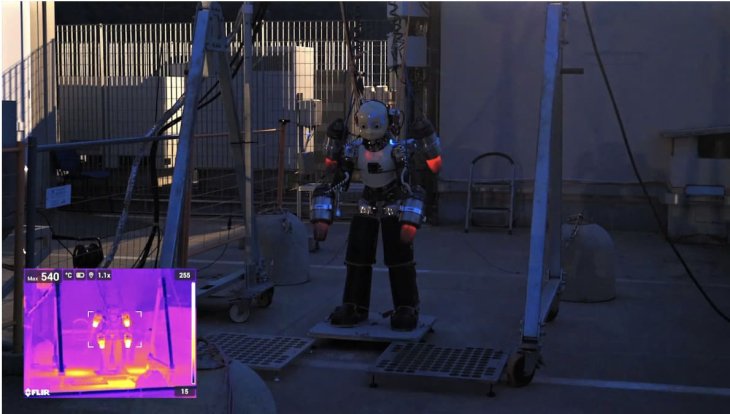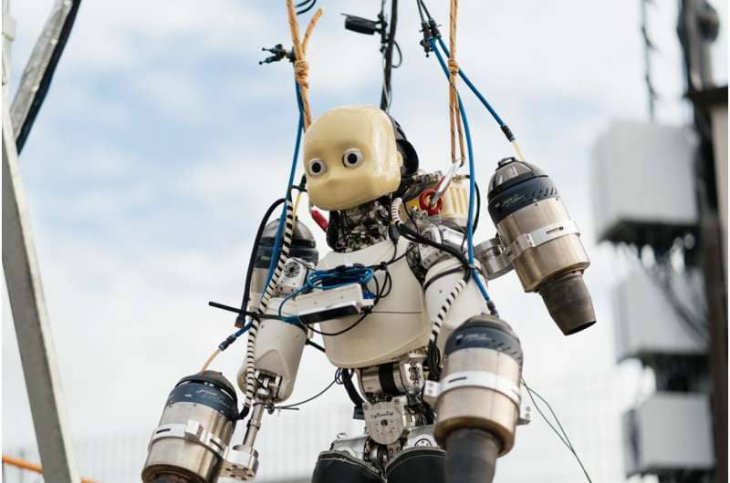World's First Flying Humanoid Robot Takes Flight
Karamchand - Jun 24, 2025

A humanoid robot hovers 50cm off the ground, balancing mid-air with jet engines and AI control. Meet the world's first flying humanoid robot breakthrough.

Iron Man Becomes Reality: The Flying Robot Revolution
Forget everything you thought you knew about robotics. Scientists just created something straight out of science fiction: a flying humanoid robot that hovers above ground like a mechanical superhero. This isn't CGI or movie magic – it's real, and it's absolutely mind-blowing.
The Italian Institute of Technology (IIT) just unveiled iRonCub3, officially the world's first humanoid robot capable of flight using jet turbines. Moreover, this achievement marks a pivotal moment in multi-terrain robotics research, especially for rescue missions and disaster response scenarios that desperately need advanced technological support.
The Jet-Powered Mechanical Marvel
iRonCub3 packs some serious firepower with four jet engines – two mounted on its arms and two attached to its back. These engines generate over 1,000 newtons of thrust, easily lifting the robot's 70-kilogram frame off the ground. Furthermore, a titanium spine and heat-resistant shell protect the robot from scorching exhaust gases reaching 800°C.
Think of it as Iron Man's younger, more practical sibling. However, this robot faces challenges Tony Stark never had to worry about in the movies.
Why Flying Humanoids Are Ridiculously Hard to Build
Unlike symmetrical, stable drones, humanoid robots present unique aerodynamic nightmares. Their human-like shape with flexible limbs creates constant airflow disruptions and shifting center-of-gravity issues. Additionally, every movement changes the robot's flight characteristics in real-time.
To tackle this challenge, IIT researchers collaborated with Milan Polytechnic and Stanford University. Together, they developed an AI-integrated flight control system using neural networks trained on both simulation and real-world data. Consequently, iRonCub3 can adjust its flight posture, handle turbulent airflow, and execute sequential jet startup during takeoff.
The Secret Sauce: Co-Design Engineering
The development process utilized "co-design" methodology, simultaneously optimizing body shape and engine placement for maximum flight efficiency. Furthermore, extensive simulation testing, thermal management, thrust sensors, and takeoff-landing algorithms underwent meticulous fine-tuning.
This wasn't just bolting jet engines onto an existing robot. Instead, engineers redesigned everything from scratch to create a flying machine that happens to look human rather than a human-shaped machine that accidentally flies.
Real-World Applications That Matter
According to Daniele Pucci, head of the Artificial and Mechanical Intelligence Lab (AMI Lab) at IIT, this robot's design aims to expand operational capabilities in harsh and unpredictable environments. Specifically, iRonCub could revolutionize disaster rescue missions, toxic environment surveys, and autonomous navigation in complex confined spaces.
Imagine rescue scenarios where traditional robots can't reach trapped victims. Now, picture a flying humanoid robot soaring over debris, landing precisely where needed, and providing assistance with human-like dexterity. That's the future this technology promises.
The Technical Wizardry Behind the Magic
The engineering challenges were absolutely staggering. First, the team had to solve heat management issues from 800°C exhaust temperatures. Additionally, they needed to create control systems that could handle a constantly shifting center of gravity.
The AI control system represents perhaps the most impressive achievement. Neural networks process thousands of sensor inputs per second, making split-second adjustments to thrust vectors and body positioning. Moreover, the system learned from extensive simulation data before ever attempting real flight.
What Makes This Different from Drones
Standard drones are essentially flying cameras with simple, symmetrical designs. However, humanoid robots must maintain upright posture while managing complex limb movements and weight distribution. Furthermore, they need to land gracefully and transition seamlessly between flight and ground operations.
iRonCub3 bridges this gap by combining aerial mobility with ground-based manipulation capabilities. Therefore, it represents a completely new category of robotic platform that doesn't exist elsewhere.

The Future of Flying Humanoid Robots
In the coming period, iRonCub3 will undergo outdoor testing at Genoa Airport, preparing for advanced integration of flying robot technology into practical applications. These tests will push the boundaries of what's possible with autonomous flying humanoids.
The implications extend far beyond rescue operations. Subsequently, we might see flying humanoid robots in construction, maintenance, exploration, and even space missions where traditional mobility solutions fall short.
The Challenges Still Ahead
Despite this breakthrough, significant obstacles remain. Battery technology limits flight time, weather conditions affect stability, and regulatory frameworks don't yet accommodate flying humanoid robots. Additionally, the technology needs to become more robust and cost-effective for widespread adoption.
However, every revolutionary technology faces similar hurdles initially. The Wright brothers' first flight lasted only 12 seconds, yet it changed transportation forever.
When Science Fiction Becomes Science Fact
The creation of the world's first flying humanoid robot represents more than just technological achievement. It demonstrates humanity's relentless drive to push boundaries and solve seemingly impossible challenges. Furthermore, it brings us one step closer to the sci-fi futures we've always imagined.
iRonCub3 proves that with enough ingenuity, determination, and advanced engineering, even the most fantastic concepts can become reality. The age of flying humanoid robots has officially begun.
The Bottom Line: The Future Just Landed
When scientists create a flying humanoid robot that hovers with jet engines and AI control, they're not just building a cool gadget. They're opening doors to entirely new possibilities for rescue, exploration, and human assistance.
Most importantly, iRonCub3 shows that the future doesn't wait for permission – it arrives when brilliant minds refuse to accept limitations. The world's first flying humanoid robot is here, and it's just the beginning.
Featured Stories

ICT News - Dec 25, 2025
The Visibility Concentration Effect: Why Half the Web Isn’t Qualified Anymore

ICT News - Jul 05, 2025
Windows 11 is Now the Most Popular Desktop OS in the World

ICT News - Jul 02, 2025
All About Florida’s Alligator Alcatraz: A Smart Move for Immigration Control

ICT News - Jun 25, 2025
AI Intimidation Tactics: CEOs Turn Flawed Technology Into Employee Fear Machine

ICT News - Jun 24, 2025
Tesla Robotaxi Finally Hits the Streets: $4.20 Rides That'll Make You Hold Your...

ICT News - Jun 24, 2025
When Closed Source Met Open Source: Bill Gates Finally Meets Linus Torvalds After...

Gadgets - Jun 23, 2025
COLORFUL SMART 900 AI Mini PC: Compact Power for Content Creation

ICT News - Jun 22, 2025
Neuralink Telepathy Chip Enables Quadriplegic Rob Greiner to Control Games with...

ICT News - Jun 20, 2025
Tesla vs Zoox vs Waymo: Who would win?

ICT News - Jun 19, 2025
Comments
Sort by Newest | Popular